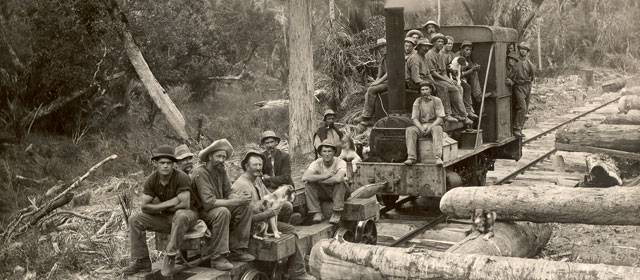Story summary
In the 19th century, bushmen had a tough time working in the native forests. Once a tree was felled, they cut it into logs up to 20 metres long. Then they had to get the logs to the timber mill. At the mill it was sawn into planks for building houses, bridges and other structures.
There have been many ways to transport logs.
Skidding
Skidding was simply pulling logs along the ground. Teams of Māori chanted as they pulled ropes tied to a log. They made tall tōtara trees into canoes.
Later, European bushmen used teams of 12–20 bullocks (neutered bulls), pulling logs on a sledge to the mill. The animals struggled over rough, slippery ground, sometimes breaking a leg.
Bush tramways
Tramways were tracks in the forest, laid with wooden rails. Teams of horses pulled the logs on bogies (small, wheeled carts) along the rails. It was dangerous work, and men risked being crushed by a heavy log. The last horse-drawn bush tram stopped working in 1938.
There are still remnants of wooden tramways at some sites.
In the late 19th century, steam engines (known as lokeys) replaced horses to pull the bogies. New Zealand engineers made powerful lokeys. They ran on steel rails, and had gears to get them uphill and around tight bends. From 1924 tractors were also used on the rails. They were often made from farm tractors.
As loggers moved into more rugged forest, the tramways became more daring. They ran across high bridges and very steep hillsides, and good brakes were vital. The tramways were well built, and only one bridge ever collapsed.
Moving kauri: dams and rafts
Water transport is cheap, but New Zealand has only one felled timber that floats – logs from the giant kauri of the north.
Dams were made in streams in the forest. Kauri logs were floated to the dam. Then the dam gate was opened: the power of the released water would rush the logs downstream.
The logs were then chained to form a raft and towed by boat to the mill. At Auckland they were stored at the Viaduct Basin.
Roads and trucks
In the 20th century, roads improved. Powerful logging trucks replaced the steam lokeys in rough country. By the 1950s diesel-powered trucks were pulling two trailers with a 130-tonne load of timber, and are still used today.





